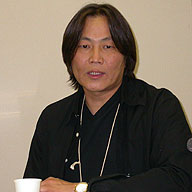An Interview with Sakhya Byamba
I Tried to Express That We’re All the Same
Q: Was this film screened in Mongolia?
SB: Only once, to a small group of people. I showed it to filmmakers in Mongolia, but there wasn’t much response. Though there wasn’t criticism, no one said it’s really great. But this film is completely different from the works they make, so it may have been difficult to understand. I was told it felt really long. Short films are hardly ever made in Mongolia, but it’s true that the tempo is slow compared to the rhythm of feature-length Mongolian films.

Q: What are your thoughts about expressing abstracts concepts like time and space through film?
SB: I’m not confident about whether or not I was able to express something invisible like time through film. Time is a really fascinating subject. For example, the contrast between time when the film is being screened, time when we shot the film, and time that actually happens at the temple…Time is a very important presence for film. I think filmmakers are able to express the rhythm of time through cinema.
I decided to make the cuts uniformly long because of the relationship with the actual temple. If I didn’t use that approach, I felt my goals in making this film wouldn’t be achieved. The flow that makes it feel long and repeatedly showing the same thing were my efforts to create the rhythm that I wanted to convey.
Q: What about the quotations from haiku?
SB: I think film is a visual art, and I try using as little language as possible. But for this film, I decided to use the minimum language. I wanted to avoid expressing things like the film process entirely with language, but I think the minimum information about what I want this film to convey should be given.
About poetry, it is a necessity for this film. I thought poetry in a form like haiku is appropriate. I was interested in haiku before, but I don’t know Japanese so I didn’t understand much. I read works translated into Russian and made the selections. Recently there have been efforts among Mongolian poets to create haiku, which is very interesting.
Q: I felt something poetic in the scene where the train tracks curve, the image of the amusement park spinning round and round, and the sounds from birds and insects off screen. I also feel thought provoking hints throughout the film.
SB: I’m really happy that it seems everyone picked up the hints that I most wanted people to get. This kind of film, something that is isolated, might be easy for audiences in Japan to understand. But of course I didn’t make this film to please the audience, and nor did I make it for audiences in Japan.
This morning I went to a mountain temple and experienced the tea ceremony, and the Chinese characters “swift water, unmoving moon” were on display. I heard it means that no matter how fast the river runs, the moon does not move. So even when the times change, there are things that stay the same. I could really relate, and thought it was nice.
Q: This work also films the basic things that don’t change in life.
SB: It’s quite a coincidence, but I think those words are perfect.
(Compiled by Watanuki Mugi)
Interviewers: Watanuki Mugi, Wada Hiroshi / Interpreter: Alimaa Zorig
Photography: Sato Akari / Video: Matsumoto Miho / 2003-10-13
